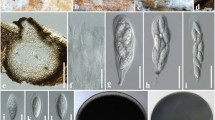Summary
The comparative morphology and pigmentation of protists suggest that those with tubular mitochondrial cristae belong to a different lineage than those with lamellar cristae and that the evolutionary divergence might have been very early. We propose that the difference in cristal morphology is the result of separate origins of the mitochondria from endosymbionts related to the Rhodospirillaceae (purple nonsulfur bacteria) but differing in the morphology of their internal membranes. Comparisons of the cytochromes c of protists and the Rhodospirillaceae and of 16s rRNA T1 oligonucleotide catalogs in the Rhodospirillaceae do not contradict, and in fact provide support for, the idea. More extensive evidence may be lacking simply because cytochromes c have been studied in very few protists with tubular mitochondrial cristae.
Similar content being viewed by others
References
Almassy RJ, Dickerson RE (1978)Pseudomonas cytochrome c551 at 2.0 resolution: Enlargement of the cytochrome c family. Proc Natl Acad Sci USA 75:2674–2678
Ambler RP, Meyer TE, Kamen MD (1976) Primary structure determination of two cytochromes c2: close similarity to functionally unrelated mitochondrial cytochrome c. Proc Natl Acad Sci 73:472–475
Baba ML, Darga LL, Goodman M, Czelusniak J (1981) Evolution of cytochrome c investigated by the maximum parsimony method. J Mol Evol 17:197–213
Dayhoff MO, Schwartz RM (1981) Evidence on the origin of eukaryotic mitochondria from protein and nucleic acid sequences. Ann NY Acad Sci 361:92–104
Dayhoff MO, McLaughlin PJ, Barker WC, Hunt LT (1975) Evolution of sequences within protein superfamilies. Naturwissenschaften 62:154–161
Dickerson RE (1980a) The cytochromes c: an exercise in scientific serendipity. In: Sigman DS, Brazier MAB (eds) The Evolution of Protein Structure and Function. Academic Press, New York, pp 173–202
Dickerson RE (1980b) Evolution and gene transfer in purple photosynthetic bacteria. Nature 283:210–212
Glover CVC, Gorovsky MA (1979) Amino-acid sequence ofTetrahymena histone H4 differs from that of higher eucaryotes. Proc Natl Acad Sci USA 76:585–589
Gray MW, Doolittle WF (1982) Has the endosymbiont hypothesis been proven? Microbiol Rev 46:1–42
John P, Whatley FR (1977)Paracoccus denitrificans Davis (Micrococcus denitrificans Beijerinck) as a mitochondrion. Adv Bot Res 4:51–115
Leadbeater BSC, Manton I (1974) Preliminary observations on the chemistry and biology of the lorica in a collared flagellate (Stephanoeca diplocostata Ellis). J Mar Biol Assoc UK 54: 269–276
Mahler HR (1983) The exon: intron structure of some mitochondrial genes and its relation to mitochondrial evolution. Int Rev Cytol 82:1–98
Manton I (1959) Electron microscopical observations on a very small flagellate: the problem ofChromulina pusilla Butcher. J Mar Biol Assoc UK 38:319–333
Pfennig N, Truper HG (1973) The Rhodospirillaceae (phototrophic or photosynthetic bacteria). In: Laskin AI, Lechevalier HA (eds) CRC Handbook of Microbiology, Vol I. CRC Press, Cleveland, pp 17–27
Pfennig N, Truper HG (1983) Taxonomy of phototrophic green and purple bacteria: a review. Ann Microbiol 134(B):9–20
Schwartz RM, Dayhoff MO (1978a) Origins of prokaryotes, eukaryotes, mitochondria, and chloroplasts. Science 199:395–403
Schwartz RM, Dayhoff MO (1978b) Cytochromes. In: Atlas of protein sequence and structure. Vol 5, Suppl 3. National Biomedical Research Foundation, Washington, DC, pp 29–45
Stackebrandt E, Woese CR (1981) The evolution of prokaryotes. In: Carlile MJ, Collins JF, Moseley BEB (eds) Molecular and Cellular Aspects of Microbial Evolution. Cambridge University Press, Cambridge, pp 1–31
Stewart KD, Mattox KR (1980) Phylogeny of phytoflagellates. In: Cox ER (ed) Phytoflagellates. Vol. 2, Developments in Marine Biology. Elsevier/North Holland, Inc., New York, pp 433–462
Tarr GE, Fitch WM (1976) Amino acid sequence of cytochrome c fromTetrahymena pyriformis Phenoset A. Biochem J 159: 193–199
Taylor FJR (1978) Problems in the development of an explicit hypothetical phylogeny of the lower eucaryotes. BioSystems 10:67–89
Whatley FR (1981) The establishment of mitochondria:Paracoccus andRhodopseudomonas. In: Fredrick JF (ed), Origins and Evolution of Eukaryotic Intracellular Organelles. Ann NY Acad Sci 361:330–340
Woese CR (1977) Endosymbionts and mitochondrial origins. J Mol Evol 10:93–96
Woese CR, Gibson J, Fox GE (1980) Do genealogical patterns in purple photosynthetic bacteria reflect interspecific gene transfer? Nature 283:212–214
Author information
Authors and Affiliations
Rights and permissions
About this article
Cite this article
Stewart, K.D., Mattox, K.R. The case for a polyphyletic origin of mitochondria: Morphological and molecular comparisons. J Mol Evol 21, 54–57 (1984). https://doi.org/10.1007/BF02100627
Received:
Revised:
Issue Date:
DOI: https://doi.org/10.1007/BF02100627




